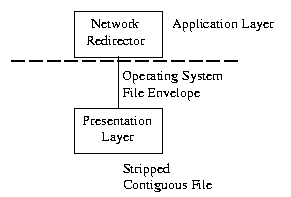|
Introduction to Data Communications
32c. Layer 6 - Presentation Layer
32c. Layer 6 - Presentation Layer
The Network Redirector directs CPU operating system native code to the network operating system. The coding and format of the data is not recognizable by the network operating system. The data consists of file transfers and network calls by network aware programs.
As an example: when a dumb terminal is used as a workstation in a mainframe or minicomputer network, the network data is translated into and from the format that the terminal can use. The Presentation layer presents data to and from the terminal using special control characters to control the screen display (LF-linefeed, CR-carriage return, cursor movement, etc..). The presentation of data on the screen would depend on the type of terminal VT100, VT52, VT420, etc.

Similarly, the Presentation layer strips the pertinent file from the workstation operating system's file envelope. The control characters, screen formatting and workstation operating system envelope are stripped or added to the file, depending on if the workstation is receiving or transmitting data to the network. This could also include translating ASCII files characters from a PC world to EBCDIC in an IBM Mainframe world.
The Presentation Layer also controls security at the file level. This provides file locking and user security. The DOS Share program is often used for file locking. When a file is in use, it is locked from other users to prevent 2 copies of the same file to be generated. If 2 users both modified the same file and User A saved it then User B saved it - User A's changes would be erased!
At this point, the data is contiguous and complete at this point (one large data file). See Fig. 4.
|